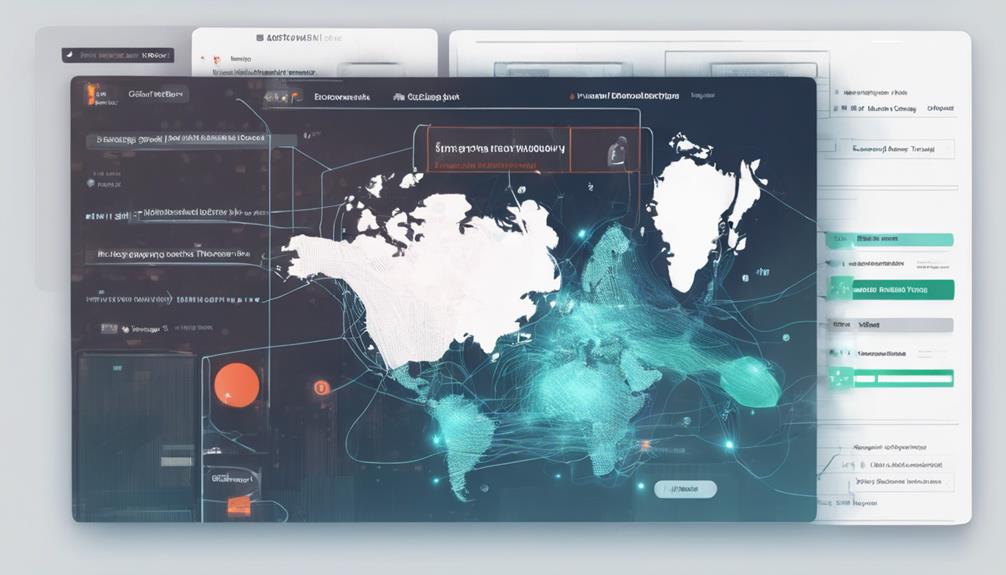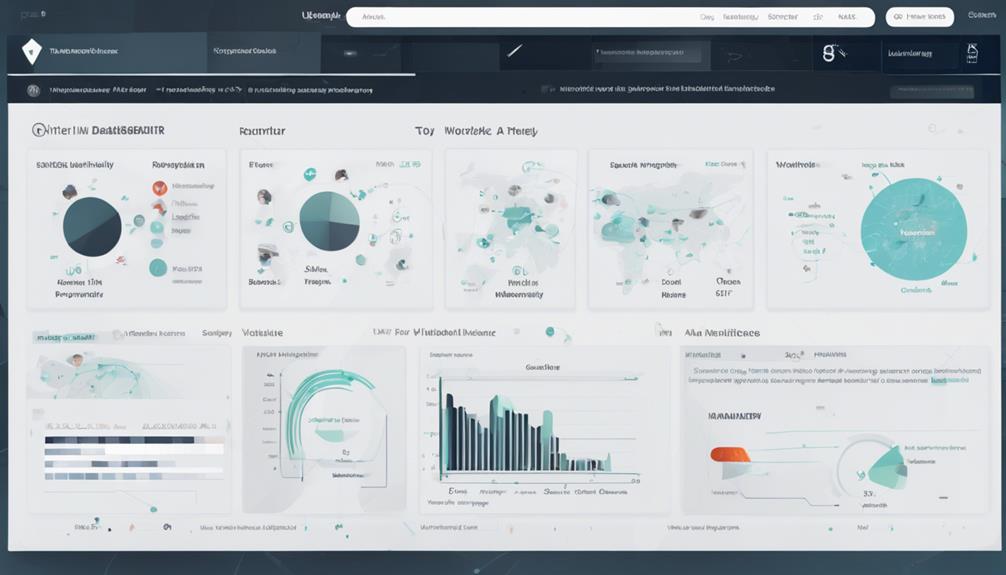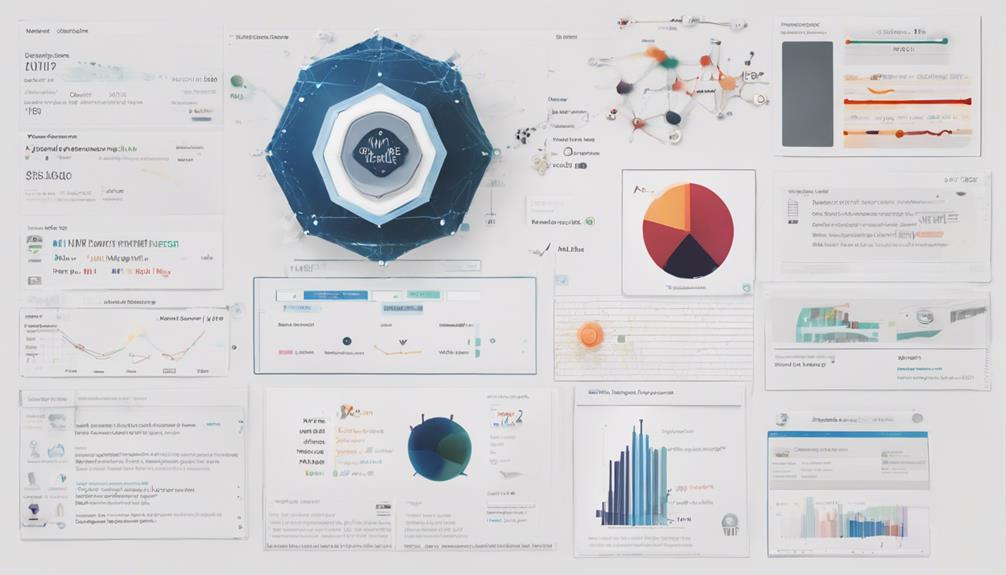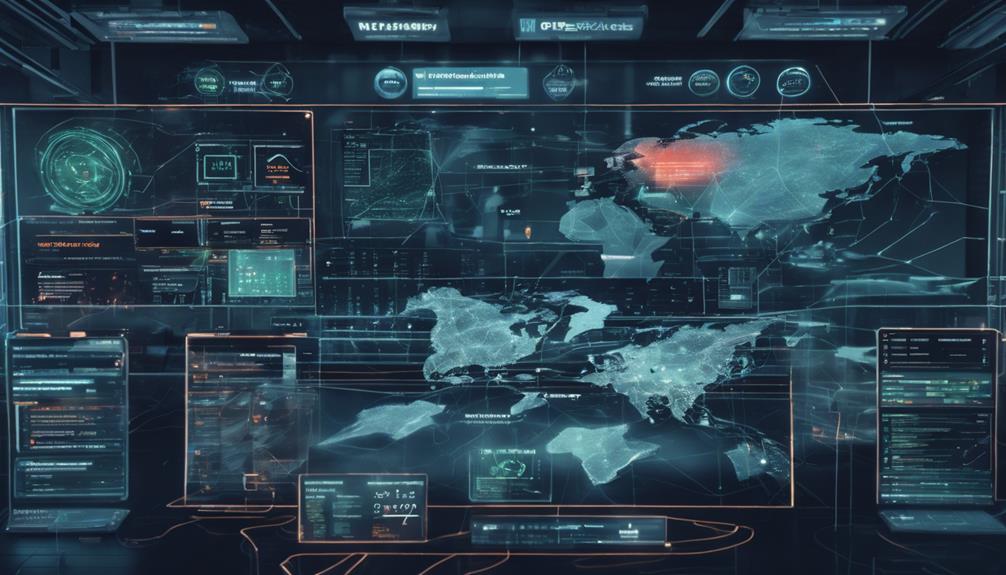In the dynamic field of cybersecurity, top AI tools like Sophos Intercept X and Symantec Endpoint Security excel at threat detection. Splunk User Behavior Analytics and Vectra Threat Detection enhance proactive security measures. AI-driven tools offer real-time identification of security risks while reducing false positives. This proactive approach aids in anomaly detection and breach prevention. Real-time threat identification with tools like Microsoft Security Copilot is indispensable. Automation, like with Darktrace, improves incident response instantly. By optimizing risk assessment and vulnerability management, AI establishes itself as a game-changer in cybersecurity defense. Learn more about cutting-edge AI technologies transforming cybersecurity.
Key Takeaways
- Sophos Intercept X utilizes deep learning for threat detection.
- Symantec Endpoint Security features machine learning exploit prevention.
- Splunk User Behavior Analytics establishes baseline user behavior.
- Vectra Threat Detection uses behavioral analytics for security.
- AI cybersecurity tools provide proactive defense and enhance data security.
Importance of AI in Cybersecurity
Utilizing the power of artificial intelligence (AI) is vital in bolstering cybersecurity defenses against the escalating threats in today's digital landscape. With cyber threats on the rise and organizations facing a shortage of cybersecurity professionals, AI technology plays an essential role in enhancing security measures. AI tools, leveraging deep learning and machine learning algorithms, have become indispensable in identifying vulnerabilities and mitigating risks effectively.
These advanced technologies enable proactive security measures, allowing companies to stay one step ahead of cybercriminals. Industries embracing digital transformation benefit greatly from integrating AI into their cybersecurity strategies, especially for firms lacking in-house cybersecurity expertise. AI-powered tools like Sophos Intercept X and Symantec Endpoint Security are at the forefront of employing AI for advanced threat detection, helping organizations safeguard their digital assets more efficiently.
Top AI Cybersecurity Tools

The utilization of leading AI cybersecurity tools is imperative for organizations seeking robust defense mechanisms against evolving cyber threats. These advanced tools harness machine learning algorithms and user behavior analytics to provide proactive defense and enhance data security.
Here are four top AI cybersecurity tools that are making waves in the industry:
- Sophos Intercept X: Utilizes deep learning technology for threat detection and adaptation over time.
- Symantec Endpoint Security: Features machine learning exploit prevention and automates endpoint updates for enhanced endpoint protection.
- Splunk User Behavior Analytics: Establishes baseline user behavior and detects potential breaches, aiding in incident response.
- Vectra Threat Detection and Response: Uses behavioral analytics to uncover hidden threats across environments, bolstering threat intelligence capabilities.
Machine Learning for Threat Detection

Machine learning plays a vital role in enhancing cybersecurity defenses by improving threat detection capabilities.
By analyzing data patterns and anomalies, ML algorithms enable real-time identification of potential security risks.
This proactive approach minimizes false positives and enhances behavioral analysis to swiftly respond to emerging threats, making cybersecurity systems more robust and efficient.
ML in Anomaly Detection
Artificial intelligence plays a pivotal role in enhancing cybersecurity through the application of machine learning in anomaly detection for threat identification. ML algorithms in anomaly detection are essential for spotting unusual patterns or behaviors in data that could indicate security breaches or potential threats.
Here are four key points highlighting the significance of ML in anomaly detection:
- Improved Threat Detection Accuracy: ML algorithms excel at analyzing vast amounts of data to detect anomalies accurately, reducing false positives and enhancing overall threat detection accuracy.
- Adaptability to New Threats: By leveraging historical data, ML models can evolve and adapt to detect new and emerging threats in real-time, staying ahead of cyber adversaries.
- Enhanced Cybersecurity Strategies: ML in anomaly detection forms a critical component of cybersecurity strategies, bolstering organizations' ability to proactively identify and respond to threats effectively.
- Uncovering Unnoticed Threats: ML algorithms help uncover security threats that may bypass traditional security measures, providing a robust layer of defense against cyber attacks.
Real-Time Threat Identification
Enhancing cybersecurity through real-time threat identification involves leveraging machine learning for dynamic and adaptive threat detection capabilities. AI-driven behavior analysis plays an essential role in enhancing the accuracy of threat detection by continuously analyzing vast amounts of data for anomalies.
By adapting continuously to new cyber threats, AI tools like Microsoft Security Copilot and Tessians Complete Cloud Email Security help organizations react instantly, staying ahead of potential damage. These AI-driven systems not only minimize the impact of cyber threats but also reduce false positives, improving overall detection rates.
Real-time threat identification is indispensable in the ever-evolving landscape of cybersecurity, where threats can emerge rapidly and cause significant harm. By harnessing the power of AI for threat detection, organizations can proactively protect their systems and data from malicious actors, ensuring a more secure digital environment.
Embracing AI tools for real-time threat identification is a proactive step towards robust cybersecurity practices in today's digital age.
Enhancing Incident Response With AI

AI is revolutionizing incident response by automating complex tasks, offering real-time responses to security threats, and enhancing overall efficiency.
Tools like Microsoft Security Copilot and Darktrace leverage AI to provide automated incident response capabilities, enriching investigation information instantly.
With AI-driven continuous feedback loops, organizations can effectively respond to security incidents, improving threat detection and response times.
AI in Incident Response
Utilizing advanced artificial intelligence technology in incident response processes greatly enhances the efficiency and effectiveness of cybersecurity teams. AI automates complex tasks, allowing teams to focus on strategic decision-making rather than manual labor. Tools such as Microsoft Security Copilot and Darktrace provide instant enrichment of investigation information, enabling quick identification of threats.
- AI-driven continuous feedback loops, like those in Darktrace, enhance incident response capabilities by learning from each security incident to improve future responses.
- Real-time threat reaction is a key feature of AI tools, ensuring that cybersecurity teams can swiftly respond to emerging threats without delay.
- By reducing manual efforts during security incidents, AI enables teams to allocate resources more effectively, enhancing overall operational efficiency.
- The ability of AI in incident response to provide instant enrichment of data allows for quicker decision-making and more effective responses to cyber threats.
Automated Threat Detection
Automated threat detection plays a pivotal role in optimizing incident response strategies through the integration of artificial intelligence technology. AI in cybersecurity leverages machine learning models to enable real-time analysis for swift threat identification.
By employing automated tools like Microsoft Security Copilot and Darktrace, organizations can enhance their incident response capabilities by reacting to threats promptly. These AI platforms enrich investigation information instantly, enabling security teams to analyze patterns and behaviors efficiently.
Additionally, tools such as Tessians Complete Cloud Email Security utilize AI for real-time threat detection and prevention, safeguarding against potential cybersecurity breaches. By harnessing the power of AI for automated threat detection, organizations can strengthen their cybersecurity posture, saving time and resources during security incidents.
Implementing AI-driven solutions guarantees that threats are detected and mitigated swiftly, enhancing overall cybersecurity resilience.
Real-time Response Improvement
Enhancing incident response capabilities with artificial intelligence technology involves leveraging real-time data analysis for swift threat mitigation. AI plays a significant role in improving response effectiveness by enabling automated incident response processes and enhancing incident investigation.
Here are four key ways AI contributes to real-time response improvement in cybersecurity incidents:
- Automation: AI automates complex tasks, saving time and enabling a faster response to security incidents.
- Enriched Investigation: Tools like Microsoft Security Copilot and Darktrace enrich investigation information instantly, leading to more efficient incident response.
- Continuous Feedback Loop: Darktrace utilizes an AI-driven continuous feedback loop to continuously improve incident response strategies.
- Swift Response: AI reacts to threats in real-time, providing organizations with the ability to swiftly and effectively respond to cyber threats.
AI in Vulnerability Management

Artificial Intelligence greatly enhances vulnerability management processes by leveraging advanced algorithms to automate critical tasks.
AI in vulnerability management involves automating vulnerability scanning to efficiently prioritize and remediate critical vulnerabilities. Through predictive analysis, AI can identify potential future vulnerabilities before they are exploited, reducing the time window for attackers to strike by deploying patches promptly.
By analyzing patterns and behaviors, AI enhances vulnerability management by proactively identifying threats. Additionally, AI plays an important role in minimizing cybersecurity risks by effectively automating patch management processes.
This advanced technology not only streamlines the identification of vulnerabilities but also guarantees that remediation efforts are targeted and prompt. Incorporating AI into vulnerability management strategies can significantly improve a company's cybersecurity posture by efficiently managing vulnerabilities and reducing the window of opportunity for potential cyber attacks.
AI for Malware Analysis

AI technology revolutionizes the analysis of malware by automating processes to swiftly detect and respond to potential threats. Leveraging machine learning algorithms, AI tools enhance threat detection and response capabilities in cybersecurity.
Here are four key ways AI is transforming malware analysis:
- Enhanced Detection Accuracy: AI systems excel at identifying malware behavior patterns, enabling quicker and more precise threat detection than traditional methods.
- Efficient Response to New Threats: AI aids in detecting and responding to evolving variants of malware by continuously updating its algorithms to counter future threats effectively.
- Improved Endpoint Security: AI in malware analysis strengthens endpoint security measures, ensuring thorough protection against cyber threats across devices and networks.
- Advanced Data Loss Prevention: Through AI security solutions like ReversingLabs and FireEye, organizations can implement robust data loss prevention (DLP) strategies, safeguarding sensitive information from malicious attacks.
As AI continues to evolve, the future of malware analysis promises even greater efficiency in combating cybersecurity risks.
Ethical Hacking With AI

Utilizing artificial intelligence (AI) technology, ethical hacking is revolutionized through automated penetration testing tasks and the identification of system vulnerabilities. AI-enhanced ethical hacking involves simulating cyber attacks to test and enhance techniques, allowing for a vital approach to cybersecurity.
By integrating AI, reverse engineering processes are accelerated, aiding in the analysis of malware behavior and the discovery of potential threats. Tools such as Cobalt Strike and Metasploit leverage AI to conduct more efficient penetration testing, enabling organizations to strengthen their defenses against evolving cyber threats.
Ethical hacking with AI not only streamlines the detection of vulnerabilities but also facilitates the prompt and effective mitigation of security risks. AI-driven ethical hacking plays an essential role in enhancing security measures by continuously monitoring systems, detecting potential weaknesses, and proactively addressing vulnerabilities.
Through the marriage of AI and ethical hacking, organizations can better protect their digital assets and stay ahead in the ever-changing landscape of cybersecurity.
AI for Risk Assessment

Sophisticated AI technologies are transforming the landscape of risk assessment in cybersecurity. AI in risk assessment leverages real-time data analysis to accurately predict potential cyber threats, aiding proactive strategies to mitigate vulnerabilities.
Leading AI-driven tools like Kenna Security and RiskSense offer valuable insights to enhance an organization's security posture by evaluating the impact of vulnerabilities. Additionally, AI models prioritize security measures based on the severity and likelihood of threats, optimizing risk management efforts.
Frequently Asked Questions
What AI Is Used in Cybersecurity?
In cybersecurity, AI tools such as Sophos Intercept X, Symantec Endpoint Security, Splunk User Behavior Analytics, Vectra Threat Detection, and IBM QRadar Advisor With Watson are utilized for threat detection, user behavior analysis, and security automation, enhancing protection against cyber threats effectively.
Which Is Best, AI or Cyber Security?
In the domain of cybersecurity, the symbiotic relationship between AI and security measures is essential. Rather than determining a superiority between AI and cybersecurity, their collaboration is paramount to effectively safeguarding against dynamic cyber threats.
Can AI Overtake Cyber Security?
In the domain of cybersecurity, the question of whether AI can overtake traditional security measures is a topic of debate. AI's rapid evolution and adaptability pose a potential to revolutionize cybersecurity practices, augmenting human capabilities.
What Is the Future Use of AI in Cyber Security?
The future use of AI in cybersecurity entails leveraging predictive analytics, automated incident response, and threat hunting to fortify security measures. Machine learning and natural language processing will be pivotal in detecting and mitigating evolving cyber threats efficiently.
Conclusion
To sum up, embracing the power of AI in cybersecurity is essential in defending against evolving threats.
By utilizing top AI tools and technologies such as machine learning for threat detection, incident response enhancement, vulnerability management, malware analysis, ethical hacking, and risk assessment, organizations can strengthen their defenses and stay ahead of cyber attacks.
As the saying goes, 'Knowledge is power,' and with AI in cybersecurity, we empower ourselves to protect against digital threats effectively.









